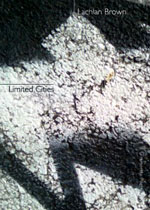
Wide suburban similes
Limited Cities by Lachlan Brown
Giramondo (2012)
A meditation on city limits – the literal and figurative limits of cities – and the edges of ‘urban’ definition, Lachlan Brown’s first collection, Limited Cities, conveys the extreme contrasts and contradictions of suburban environments via train-window views. Macquarie Fields, Parisian banlieues and Barcelona street scenes: each keen observation of the space through which he moves contributes to a nuanced description of the poet’s perspective, and in turn the reader’s too. What at first appears to be a collection concerned with the external – landscapes and cityscapes – is, in fact, more personal.
A description of Macquarie Fields’ tough cul-de-sacs reveals Brown’s subtly ironic sense of pride and ownership over the setting.
within these cul-de-sacs you have to earn any hint or breath of change. You have to pay with sweat, with grease on a two-stroke, with teeth set like wire-cutters, ready to meet the fenced-edge of the landscape (17).
In ‘Urban Sprawl’, Brown positions himself between the ‘hooded kids’ who ‘throw rocks ‘the/ size of large golf balls’ and members of the gated community. The poet is ‘somewhere/ in between … like a fallacy’ (5). Existing in the middle of the proverbial tracks allows Brown to identify with both the rioters and the gentrified, as the suburb is influenced by both its urban and rural limits without being defined by either.
Brown allows similes to leap from one rail of the social track to the other, elevating the conventionally mundane and deflating the commonly revered. Is the poet’s in-between state ‘like a fallacy’ because a fallacy is believed by some and recognised as a misconception by others? Earlier in the same poem, the day is ‘brilliant as a fire escape’ – as brilliant as an exit in an emergency, or as a steel staircase shining against a concrete wall? These types of intricate simile often suggest a deliberate ambivalence rather than a lack of technical control. There are occasions when this repeated metaphoric effect is less successful. For instance, in ‘Numbering the Days’, Brown writes of joggers: ‘Indeed you are no longer infants balancing on low ledges/ limbs like dice/ scattering with every fall’ (35). In contrast to the suppleness of many of his similes, Brown’s comparison between runners and toddlers is dull, and the image of scattered dice imprecise. This imprecision is the exception, however as, elsewhere, Brown’s use of simile is too complex and convincing an effect.
Throughout the five parts of the collection, Brown observes his surroundings with all senses; sharing perfume samples on strips of paper, petrol fumes, fish and chips wrapped in newspaper reviews of Tetsuya’s, New South Wales heat, Parisian snow, and music – an eclectic soundtrack, modulating the tone of the environment through which each poem moves. These sensory details add a rich authenticity to Brown’s portraits of place. More importantly, they act as tangible (if ephemeral) symbols for his observations of the abstract. In ‘Lent3’, a perfume sample represents, if fleetingly, Brown’s recognition of the wider delicacy of the situation:
a sales assistant spraying that perfume onto a card onto your wrist onto the air of this delicate world (78).
Music is the most recurrent sensory motif. During train travel, headphones are ubiquitous – ‘you could be a bass player, laying down/ an easy groove that squeezes around headphones/ and tracks footprints through carriage minds’ (3). Less predictable is a hot summer wind ‘tearing branches like a string/ section opening Mahler’s Sixth’ (6). In ‘Love Song’, the sky is ‘some giant plastic/ microphone, just/ waiting to receive your voice’ (9). There often is a song in the background of the poems, helping Brown make sense of each surrounding.
In the final poem, ‘Outstretched Arms’, Debussy is consoling and consolidating as the poet waits for his brother to return from a coma. Taking a break from the hospital, the poet walks along Coogee headland.
the sea always reminds me of La Mer an orchestra
of salt & movement I imagine myself at my parents’ house
playing Debussy again . . .
the lawn with its flowers
each falling gently like a final dying note (87).
An apparently absolute ending, on closer reading these lines take on the cyclical treatment of time that is consistent throughout the collection, and to which musical motifs contribute. The flowers will remain falling. There will be many final dying notes. The seasons and train timetable will continue and songs from the 80s will carry on being played by radio stations.
Without reductive generalisation or limiting definitions, Brown gives us his suburb via a compelling series of impermanent yet recurring fragments (Π.O.’s Fitzroy poems come to mind, especially 24 Hours, as does Anthony Lynch’s treatment of Geelong in Night Train). Offering a subtle understanding of figurative urban limits and generous specificity in its literal descriptions, Limited Cities is an accomplished debut.
*The reviewer is no relation to the author









